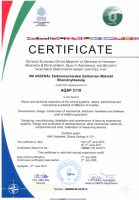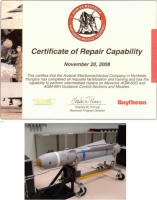
Categories
- C4I, Communication Systems
- Electrical, Electronics & Electro-optics
- Mechanical, Electro-mechanical, Hydraulic and Pneumatic components
- Radar, Sonar, Navigation, Targeting, Surveillance
- Services (R&D, training, engineering, consultancy, …)
MoD. ARZENAL Co., was founded on April 1st 1992 by the Hungarian Ministry of Defence as sole owner, to continue the work of its predecessor that was found in 1963. The purpose of its foundation was to repair the national air defense devices and to extend its range of services according to market demand.
The company’s premise can is located in the eastern region of the country, about 250 km from Budapest. The M.o.D. ARZENÁL Co. has an own siding rail with two truck loader. The buildings occupy an area of 15.000 m2, 7.000 m2 of the assembly hall is equipped with rail cranes and 400 m2 is an air-conditioned laboratory.
The company has a 45 years experience in the overhaul, manufacturing of spare parts and continuous improvement of the air defense devices. The main tasks of the company’s predecessor were the repair of missiles and radar technology devices and the related military technical devices with an exclusive right. The overhaul, middle-stage and as-required repair of these devices were performed in the premise of the M.o.D. ARZENÁL Co. Furthermore different kinds of training devices were improved and manufactured.
During the past few years, many new devices were developed and produced by M.o.D. ARZENÁL Co. The aim of the M.o.D. ARZENÁL Co. was to expand its civilian services and as a result, the company has developed a wide range of outdoor safety technology devices since 1978. New equipment is being continuously developed, according to the special market demands. Today, the company has over 350 reference works, with the devices of the M.o.D ARZENÁL Co.
To expand its offers, the M.o.D ARZENÁL Co. has been engaged in manufacturing of hospital technology equipment since 1993. The manufacturing workshop also performs subcontracting activities for foreign and domestic civilian customers.
Life Cycle Extension of Missiles
HM Arzenál Co. performs continuously the life cycle extension of guided and non-guided missiles for the Hungarian Army and other Customers since 1997. Theoretically the inspections are based on reaction kinetics and Arrhenius Svante-equation. Legal control is fulfilled according to MSZ K 1023 (CT CEB B 0100-90) military standards.
Inspection procedure consists of two main parts.
These are the on-site inspections and the destructive tests
On-site inspections:
• Number of checked samples ~10%
• Inspection of technical status, operability and statistical reliability is performed according to the Operation Instruction
• Checking the state of storing chests and the storing order
• Visual inspection of storing chests
• Checking of records
• Sampling
• Visual inspection of the missile taken off the chest
• Inspection of the missile with the introduced checking device
• Checking the availability and status of the technical support devices
• Monitoring the operator's preparedness
• Recording, results- and data processing
• Reliability analysis, determination of expiry year
Destructive tests:
• Number of checked samples ~2%, but at least 3 pieces
• Sampling
• Acceptance test, accelerated ageing, dismounting
• Inspection of the warhead
• Inspection of warhead operation
• Inspection of warhead explosives
• Inspection of rocket motor propellant
• Inspection of rocket motor operation
• Inspection of ignition device
• Inspection of initiator and tracer elements
• Inspection of power sources
• Inspection of control system units
• Recording, conclusions, expertise and proposals
Missile types in case of which HM Arzenál Co has executed the life cycle extension:
• Antitank - 9M14P1, 9M17P, 9M111, 9M113, 9M114
• Air defense - 3M8, 3M9ME, 9M31, 9M32, 9M313-1
• Airborne - R27R1, R73E, SZ5K, KO, KP, M, MO
Radar Modernization Programs
P-37 Radar
Introduction
The P-37 radar modernization program started in 1997 and the HM Arzenál Co. handed over the first modernized radar to the Hungarian Army in 1999.
In the Hungarian Army the fulfilment of the air surveillance tasks are based on these modernized P-37 radars taking part in the creation of the uniform European air space situation.
Main features of modernization:
• Preparation for toleration of increased load (24 hours operation), among different weather conditions.
• Increasing the radar's reliability and building in advanced fault diagnostics functions.
• Connection with digital signal processing and signal coupling to the modern, central air surveillance systems, even in the case when the radar is a mobile, deployed unit.
• Realization of limited height-finding capability using the digital signal processing of five receiving channels.
• Integration of secondary radar.
• Realization of analogue and synthetic radar signals integrated on a uniform displaying surface.
• Replacement of many electron tube cabinets and units by new units based on up-to-date parts, by which the reliability and availability of the radar can be improved, and the adjustment and service demand will decrease at the same time.
• Improvement of the working conditions of the operators, by creation of a more spacious air conditioned instrument cabinet, where a computer-based working place significantly helps and eases the operator's activities.
P-18 Radar
Introduction
The P-18 radar modernization program started in 2000 and the HM Arzenál Co. handed over the first modernized radar to the Hungarian Army in 2002. Nowadays the modernized P-18 radar finds its place among the modern air surveillance systems of the Hungarian Army. It is high-power, mobile, long-range radar that can be especially successfully applied for the reconnaissance of targets having small radar cross-section.
Main features of modernization:
Due to the quality of signal processing (favourable rate of false plots) and the digital signal output the radar can be connected to modern air surveillance systems with digital inputs even in the case when the radar constitutes a part of mobile, deployed unit.
• Increasing the resolution from 2 km to 1 km
• Decreasing the error of range measurement from 1800 m to 1000 m.
• Decreasing the error of azimuth measurement.
• Between 10 and 50 km from 1.5' to 1 '.
• Between 50 and 300 km from 1 ' to 0.8 '.
• Utilizing modern signal processing techniques increases the radar's clutter resistance and the capability to detect low radar cross-section targets.
• Increasing stationary target suppression from 20dB to 40dB.
• Many electron tube cabinets will be omitted and their functionality will be taken over by new units based on up-to-date parts, the reliability and availability of the radar will improve, and the adjustment and service demand will decrease at the same time.
• Working conditions of the operators will be better, being in the possession of larger place in the air conditioned cabin. Moreover, the computer-based working place significantly helps and eases the operator's activities.
• Supporting the possibility of further development towards multi-static systems.
P-18H Radar
Brief description of P-18H radar
Due to its meter wavelength range, the radar is able to detect aircrafts using stealth technology. The radar spare parts base is based on the latest commercial off-the-shelf items. Transmitter is solid state type based on pulse-compression principle. Test and diagnostic equipment are built in. The modernization improves the surveillance probability, the path of air targets is automatically tracked. The station is able to receive data from other radars, the information exchange between radars is based on agreed exchange protocol. The radar requires low maintenance, in case of newly built-in units the mean time between failures level is high (approx. 12.000 operating hours).
Description of modernization implemented on P-18 long range locator by HM Arzenál Zrt.:
The radar has newly developed hardware. The frequency range was extended and the operational frequency is increased from 4 to 41, allowing the immediate automatic frequency tuning.
The transmitter and receiver units consist of only solid state elements. The transmitter consists of modular systems, which greatly facilitates the correction of possible failures.
In the new radar station, number of vehicles is reduced from 4 to 2: equipment vehicle, antenna vehicle.
An aggregator is integrated in the equipment vehicle, which provides the radar’s smooth operation in case of power failure using an uninterruptible power supply.
Mistral Air Defense Missile System
The HM Arzenál Co. has successfully co-operated with the French-English Matra BAe Dynamics (MBD) - the winner of the "Short-range air defense missile" tender, furthermore its Italian-Swiss subcontractor, the Oerlikon Contraves (OC).
The tender's results has been announced at the beginning of year 1997. The winner had to meet its obligation to supply three Mistral air defense missile batteries till the end of year 1999. The Hungarian party specified such requirements concerning the structure and equipment of the missile batteries, for which the MBD did not dispose of outlined solutions.
The French party entered into a contract with the HM Arzenál Co. to satisfy these requirements and to perform the necessary developments and production. The HM Arzenál Co. developed and manufactured in a needed amount the Atlas Interface Platform in the frame of this contract which resolved the mounting of the MISTRAL air defense missile launch pads onto the transporting vehicles and the storing and transportation of equipment directly needed for the combat operation.
The HM Arzenál Co. furthermore developed and manufactured the company- and battery-level logistic vehicles for the transportation and operation of different spare parts and auxiliary materials, tools, test and communication devices.
Similarly, in the course of this program, the HM Arzenál Co. - as a subcontractor of the OC - manufactured the radar housings of the fire control radars of air defense missile batteries (Mistral Command Post) and the digital signal processing electronics with SMD technology. As a result of the successful co-operation the HM Arzenál Co. was the first company in Hungary, which got "NATO supplier" qualification.
The MISTRAL air defense missile system has been made suitable for the co-operation with the K-1P fire control system in 2004 . The computerized workplace of the Mistral Command Post got a TCO terminal, which is the same unit that is built in the fire control radar (SZURN) of the SA-6 system.
K-1P Fire Control Station Modernization
Introduction
The K-1P fire control system came into existence with the moderization of the Russian made K-1M complex which is the automatic centralized fire control system of various Russian missile and conventional air defense systems.
The regimental command post of the original K-1M complex was the KBU shelter that received the orders of the superior KBU and the analog signals of the local radars. The regiment had no recognized air picture (RAP) at disposal, combat operations were based solely on local sensor data. The seven-strong combat crew evaluated the analog radar information and executed manual fire distribution.
The system sent target coordinates to the battery command post (KPC) through wire or radio connection. The KPC received this telecode information and formed the neccessary analog control signals for the fire control radar (SZURN). After locking on the target the SZURN controlled the launchers and executed destruction independently.
Main features of moderization
• Modification of the K-1M complex to be suited to receive and process NATO standard data communication and fire control information
• At the command level where the K-1P system is integrated into the command and control system possibility of external control through Link11B protocol is also solved
• The system is constructed in such a way that it can be made suitable for controlling other air defense systems by replacing the fire control radar's interface unit (e.g. MISTRAL)
• Introduction of encrypted communication
• Computer aided fire distribution
• Removing the battery command post (KPC) for faster response
• Major improvement of the complex's availability time and reliability
• Simplification of deployment, reduction of number of connection cables
Modernization of AK-63F Assault Rifle
The HM ARZENÁL ZRt. is dealing with the modernization of AK-63F assault rifle since the beginning of 2013, using all of its experience acquired in the field of weapon modernization in the recent years.
The manufacturing of the original AK-63F has begun in 1964, and its huge advantage, next to other assault rifles, is that it works well between -40 and +50 Celsius degrees. One of its drawbacks was that no optical sight or any other accessories e.g. tactical lamp could be placed or fixed onto it properly.
The design of the modernized assault rifle provides the mounting of modern targeting devices and other accessories, thus it creates the possibility of prompt and accurate firing during day- and nighttime, as well as under extreme climatic conditions.
K-435N
Partial modernization of "Watchman" and "AR-51" radars - replacement of signal processing and plotter system. The following systems were replaced: signal processing system, plotter system, path forming system, remote control, displaying unit. These systems and units were developed and manufactured by the company. In these areas M.o.D. ARZENÁL Co. applied the most modern, industrial and military used components, parts and equipment. As a result of the modernization much more controlling activity can be performed from the operators workplace, and the work of the operators became more secure.
The self-written softwares provided opportunities for further simplifications. With the evolving of remote control, most of the locator activities can be tracked through an IP based network and controlled from a remote centre.
Calibration
M.o.D. ARZENAL Electromechanical Stock Company Central Measuring Laboratory
The Central Measuring Laboratory has been operating within the frameworks of the M.o.D. ARZENÁL Co. for more than 40 years (since 1966). Previously, it was the number one calibration/validation laboratory of its predecessor and for the Hungarian Army and its main task was the precision control of electronic measuring equipment, which included the calibration of pressure and temperature gauges.
The main requirement was the calibration of the measuring equipment, which was used for the repair of military devices and the repair of measuring equipment of the military devices that was sent to the repairing base. Nowadays, this equipment must comply with the requirements of the quality management systems. (ISO, AQAP).
The laboratory is continuously functioning as an accredited laboratory since 1992, and it is open to civil orders. It is currently working in the accredited status - in 18 measurement areas - under the supervision of the National Accreditation Board (NAT). The main requirement for it is the successful annual review.
The main areas of measuring (see it in the summary table) covers pressure, temperature and electrical measurements. Electrical measurement covers different measuring types from dc measurements to high-frequency measurements. The metering professionals of the lab have about 35-40 years experiences, and they also acquired the necessary knowledge for measuring of specific military equipment.
SAKER Radar
Hungarian military industry developed SPSS-1000 (Saker Portable Surveillance System), a short-range, portable, and versatile scanning system, which is suitable for moving targets close to the surface (persons, living, moving objects). It is capable of determining their distance, speed and size.
The SPSS is ideal for monitoring borders and free space as well as for monitoring protected military and civilian properties. Its low weight and mechanical design allows easy and rapid installation and transport. The SAKER radar is compliant to MIL-STD 461 standard.
The flexibility of technology provides the possibility to change the main characteristics according to the customers' requirements. The radar withstands the extreme weather conditions (snow, rain, fog), and it provides reliable and accurate measurement. In automatic remote operation mode (1-10 remote radar) one person is required for operating, which results a cost-effective operation.
General description
SPSS – 1000 (Saker Portable Surveillance System) is a short range, portable versatile FMCW based locator system which is appropriate to locate any target moving on the ground or near to ground in the air, detecting the distance, direction, and velocity of the object. It is capable of observing borders, civil or military areas and buildings.
Design and Implementation of Professional Security Systems
The HM Arzenál Electromechanical Ltd. has been dealing with design and implementation of different security, defense systems and complete security areas for 30 years. The company built up integrated security systems with complex intuitive interface from modern subsystems.
The main feature of the security systems implemented by M.o.D. ARZENÁL Co is long lifetime. They have installed many systems that work reliably for over 20 years. The company undertakes the installation of complex security systems for institutions with increased security requirements. For example: financial institutions, prisons, hospitals, schools or industrial facilities.
The company is dealing not only with direct installation of security systems, but with the architectural, building engineering, electrical engineering as a prime contractor, where qualified subcontractors are associated.
For example, they implemented the complex constructions of the Server site at the Cabinet Office. They carried out the architectural works, installation of mechanical protection, electric power supply and heating and air conditioning systems, as well as the fire and building safety protection.
M.o.D. ARZENÁL Co built the NATO filing office for the M.o.D. , the Hungarian Army, various ministries and large industrial companies, furthermore we also performed the development of radiation protected (Tempest) offices and coding offices.
The company’s activities cover almost the entire range of the security systems:
• Outdoor intrusion detection systems
• Access control system
• Camera surveillance system
• Burglar alarm system
• Mechanical protection
• Built in fire alarm and extinguishing systems
• Person and baggage control systems
Central-European Maverick Logistical Depot
The M.o.D. ARZENÁL Co. opened the depot in 2008, together with Raytheon Missile Systems (USA) at its premise in Nyírtelek.
The company has the capability to perform medium repairs on Maverick AGM-65G and AGM-65H missiles and seeker heads in accordance with all applicable laws of the United States, under the supervision of the Raytheon Missile Systems.
Technological Capabilities
Metal cutting
• Cutting
• Bandsaw machines – cutting size max: 280 mm caliber
• Plasma cutting (manual)– cutting size for steel max: 15 mm
• Flame cutting (manual)– cutting size for steel max: 50 mm
• Turning
• Traditional lathe – tipical size: 500mm – 2500 mm
• CNC lathe – tipical size: 180mm – 1000 mm
• Milling
• 3D CNC milling machine – size: 400 x 450 x 600 mm
• 4D CNC boring mill – size: 1000 x 1000 mm
• Traditional milling machine – size: 450 x 1000 mm
• CNC engraving
• Drilling
• Columnar and stream drilling machines for maximum 60 mm hole caliber
• Coordinate drilling machine with 0.001 mm precision – size: 350 x 400 mm
• Grinding
• Surface grinding – size: 350 x 800 mm
• Plain grinding – size: 200 x 750 mm caliber
• Internal grinding – size: 100 x 250 mm caliber
Metal (plate) cold working
• Cutting on hydraulic plate shears, steel: max 3 x 2000 mm
• Edge bending on hydraulic edge bending machine, steel: max 3 x 1700 mm
• Cutting, puncturing, deep drawing: max 50 t deformation force
• Rolling, steel: max 3 x 2000 mm
Welding
• Welding of steel, aluminium, stainless steel, etc
• With certificated ISO 2 and 3 welders
• With independent welding specialist
Practiced technologies
• Manual torch welding, and sealing (with copper, silver, etc.)
• Manual arc welding, with specific electrodes too
• Manual gas-shielded arc welding
• CO2 gas-shielded, consumable electrodes (ESAB machines)
• Argon gas-shielded, tungsten electrodes (Kempi, Velding machines)
Fitter works
• Manufacturing of components
• Reparing devices, parts, fittings and machines
• Manufacturing of casings and electrical switchboards
• Manufacturing precision mechanical works
• Manufactureing tools, gears and models
• Curing of unique, small-scale rubber and bakelite components
Other activites
• Preperation of shop drawings based on samples
• Preperation of 3D machining programs based on shop drawings
MoD Arzenal Electromechanical Co. (HM Arzenal Rt)
- 4461, Dózsa Gy. u. 121, Nyírtelek, Hungary
- +36 42 210 555
- +36 42 210 802
- info@hmarzenal.hu
- www.hmarzenal.hu

















